DOI: https://doi.org/10.1038/s41467-024-45095-4
PMID: https://pubmed.ncbi.nlm.nih.gov/38280849
تاريخ النشر: 2024-01-27
مُنبِث حراري ثنائي الانتقاء مع أداء مُعزز للتبريد الإشعاعي تحت المحيط
تم القبول: 15 يناير 2024
نُشر على الإنترنت: 27 يناير 2024
(أ) التحقق من التحديثات
الملخص
شيوكي وو (ب)
الملخص
التبريد الإشعاعي هو تقنية ذات طاقة صفرية تتيح التبريد دون درجة الحرارة المحيطة من خلال انبعاث الحرارة إلى الفضاء الخارجي.
استجابة في نطاق الموجات تحت الحمراء المتوسطة (MIR)، يمكن تصنيف هذه المصادر الحرارية بشكل رئيسي إلى مصادر حرارية غير انتقائية
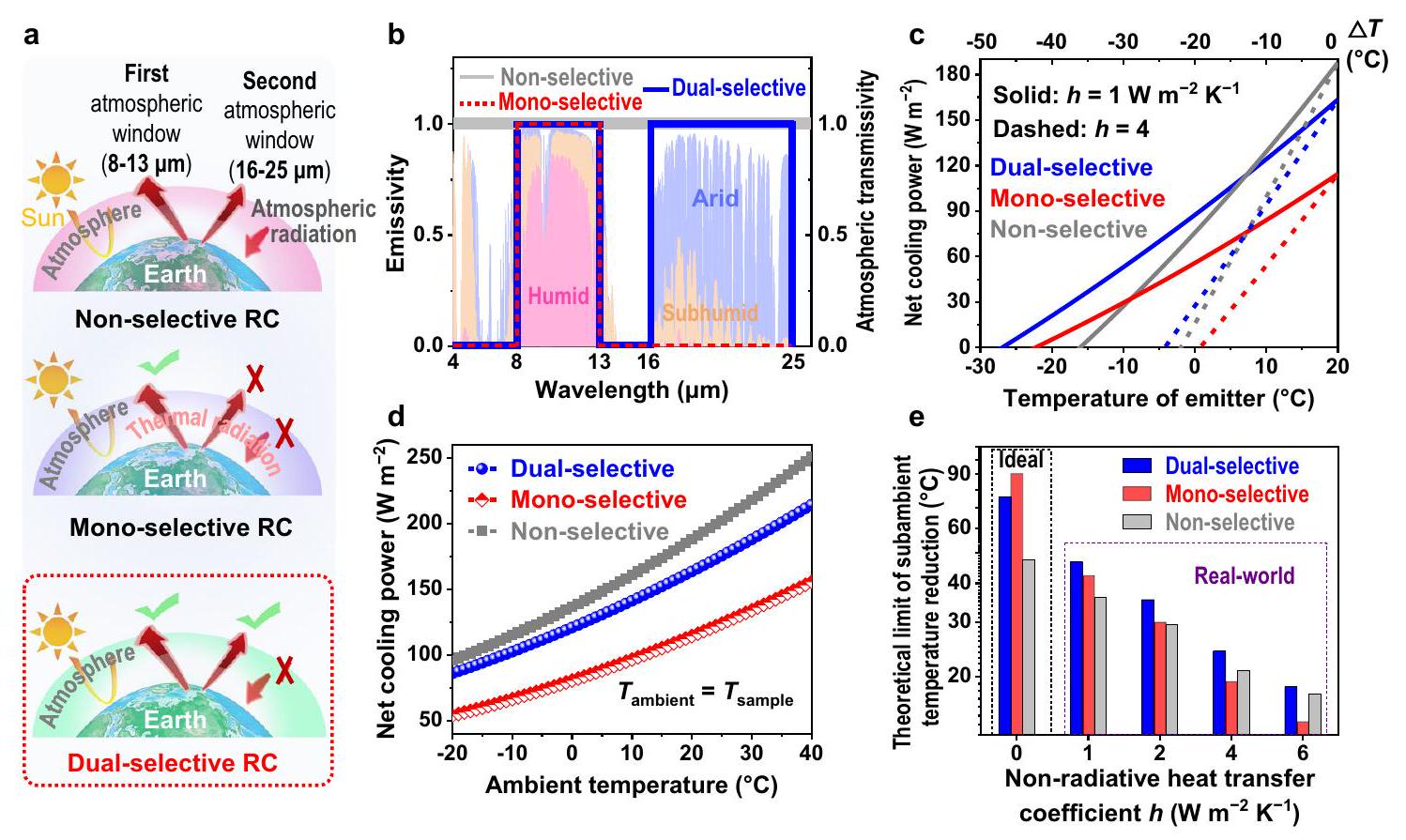
الأداء بسبب استبعاد الحرارة الطفيلية الجوية السفلية
كلا النافذتين الشفافيتين الجويتين الأولى والثانية، مما يتيح تحسين أداء التبريد الإشعاعي مقارنةً بالمنبعثات الحرارية التقليدية الموجودة. ومن المهم أن المنبعث الحراري الثنائي الانتقائية الناتج يظهر انبعاثية قدرها
النتائج
لتقييم إمكانيات التبريد من النافذة الجوية الثانية، قمنا بعرض نموذج RC مزدوج الانتقائية يتميز بانتقائية
امتصاص/انبعاث عالي في نافذتين جويتين وارتفاع عكس في باقي نطاقات الأشعة تحت الحمراء غير النافذة والأشعة الشمسية (الشكل 1 أ، ب والشكل التكميلي 1 ب). تم استخدام بيانات شفافية الغلاف الجوي في مناخ جاف (تم الحصول عليها من برنامج نمذجة ATRAN مع عمود بخار ماء يبلغ 1.0 مم وزاوية زينيث صفر) في الحساب لتعظيم تأثير التبريد للنافذة الجوية الثانية
تصميم المواد وتوصيفها
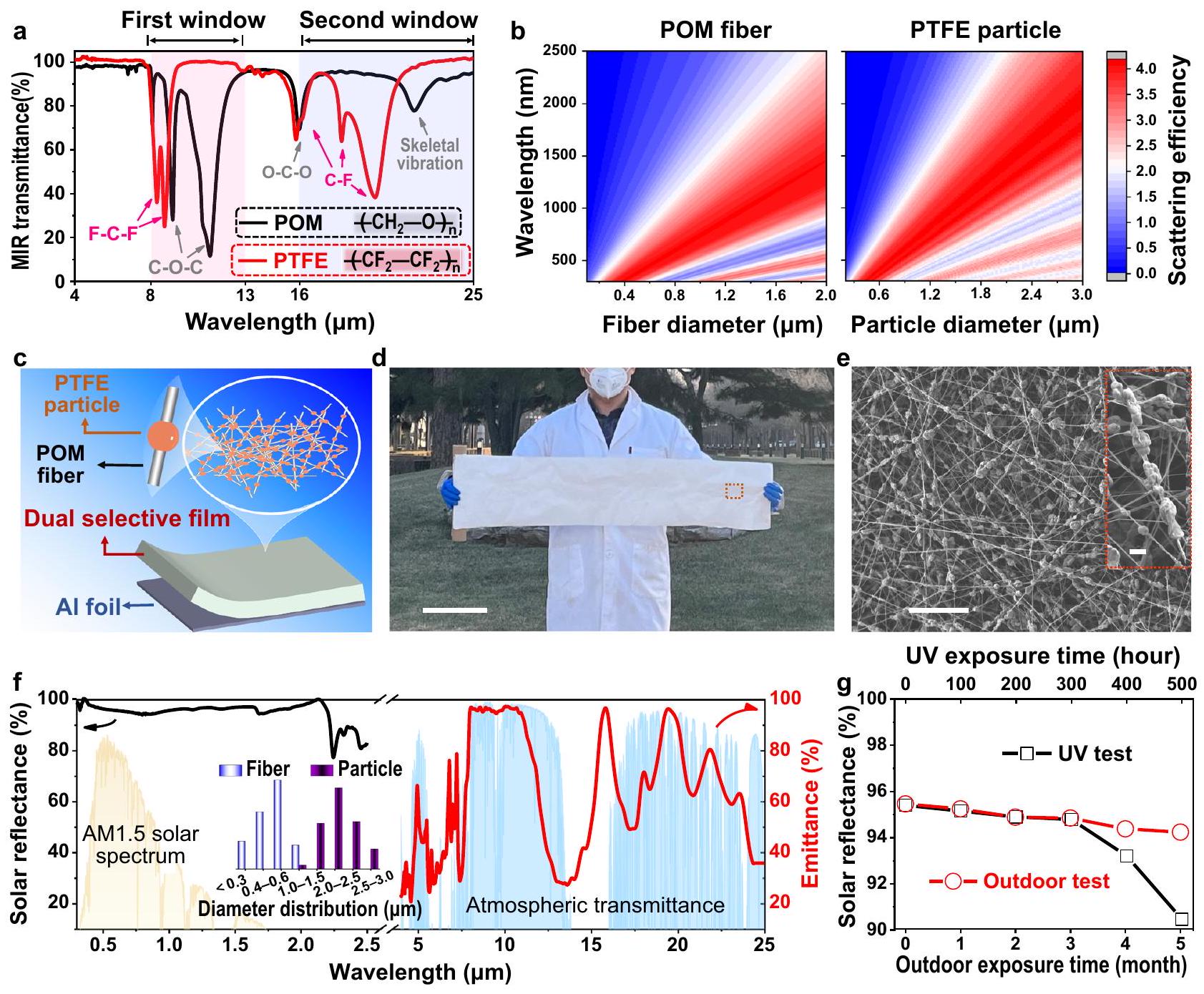
الاستقرار، مما يشير إلى إمكانية توفير أداء تبريد أفضل من أجهزة الإشعاع الحراري غير الانتقائية والانتقائية الأحادية الحالية، خاصة في المناخات الجافة.
القياسات الحرارية
يوم مشمس
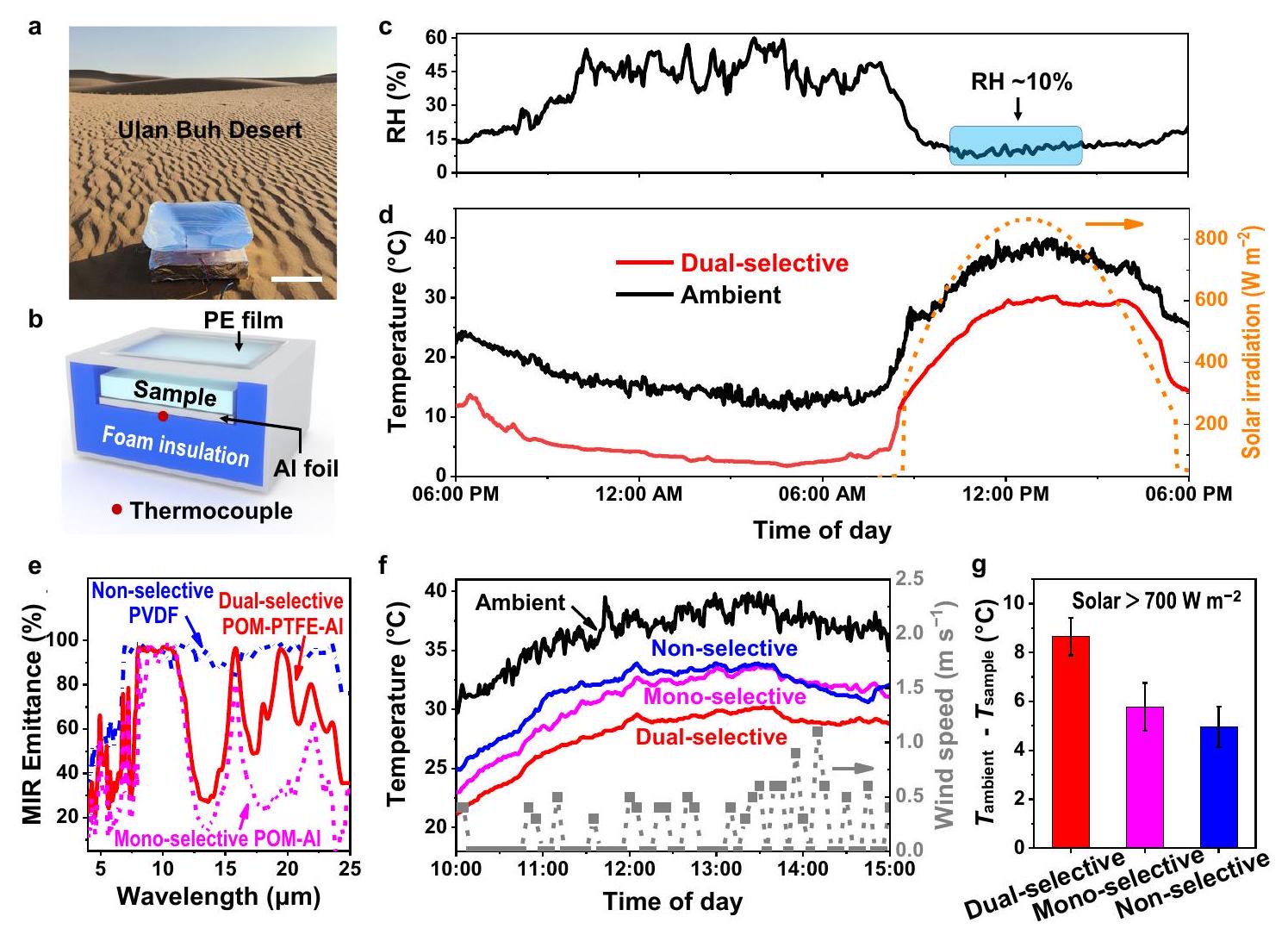
بر 2022). أ،
وذلك أيضًا بسبب خاصية الطيف الانتقائي لمادة MIR التي تسمح بأداء تبريد أفضل من العينة غير الانتقائية في بيئة ذات حرارة غير إشعاعية منخفضة (قريبة من المثالية). ومع ذلك، تختفي المزايا عندما تزداد سرعة الرياح المحيطة (من الساعة 1:00 ظهرًا إلى 3:00 ظهرًا) بسبب الزيادة في الحرارة غير الإشعاعية حول العينة الناتجة عن زيادة سرعة الرياح. ستقلل الحرارة غير الإشعاعية المتزايدة بشكل ملحوظ من أداء التبريد لمواد RC أحادية الانتقاء، حيث أن قدرتها الصافية على التبريد أقل بكثير من تلك الخاصة بالمواد غير الانتقائية.
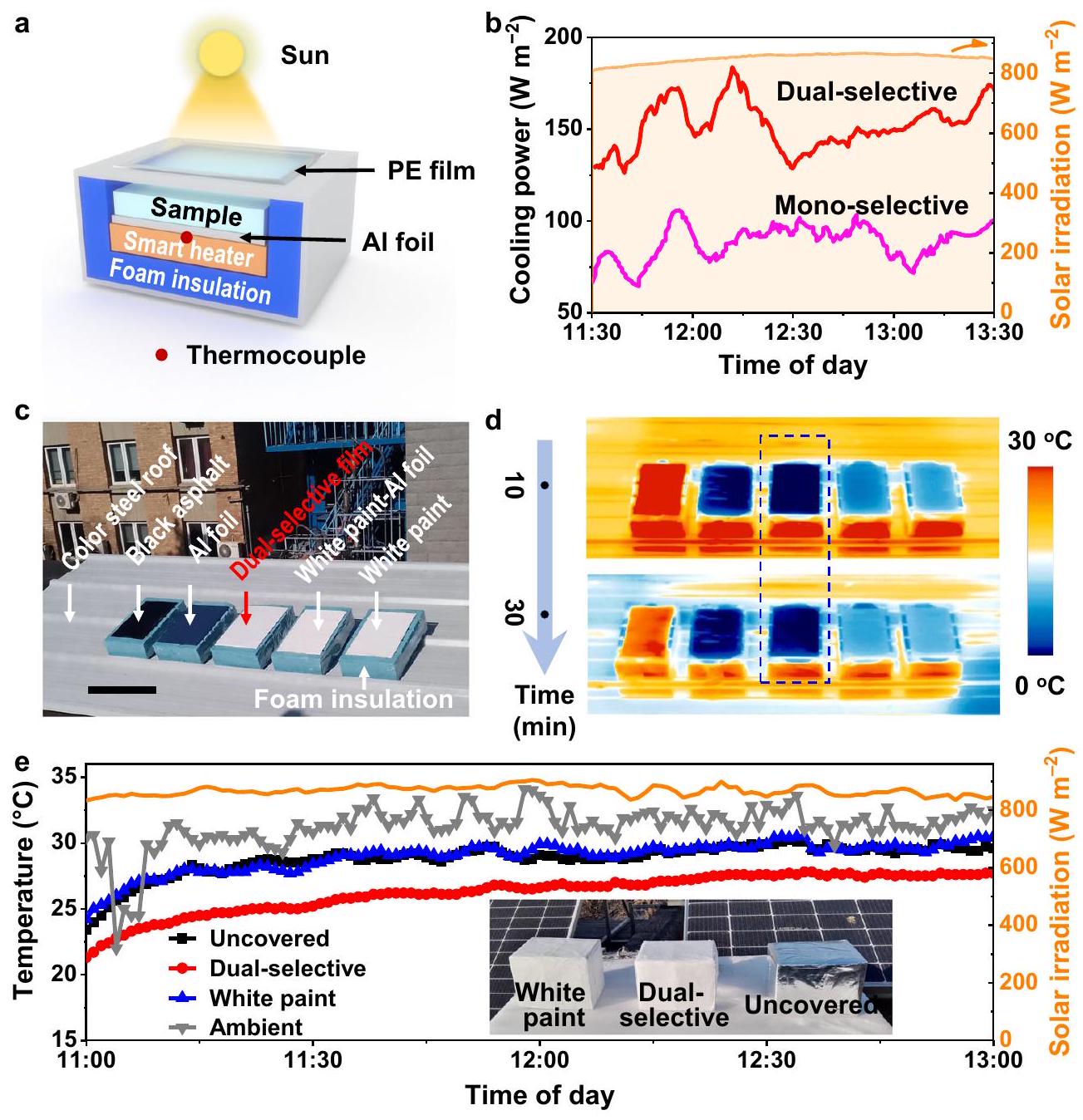
مغطاة، طلاء أبيض – مغطاة بورق الألمنيوم، ومطليّة بالطلاء الأبيض). شريط القياس في (ج)
تشير النتائج إلى أن جهاز الإشعاع الحراري الثنائي الانتقائي المصمم له أداء محسّن في التبريد الإشعاعي خلال النهار مقارنةً بالأجهزة الأحادية الانتقائية وغير الانتقائية في السيناريوهات الواقعية، خاصة في المناخات الجافة، وهو ما يتوافق بشكل جيد مع التحليل النظري (النص التكميلي 12).
تم تقديم درجة الحرارة بصريًا وتسجيلها باستخدام كاميرا الأشعة تحت الحمراء (Testo). أظهرت النتائج أن العينة ذات الاختيار المزدوج كانت لديها أدنى درجة حرارة سطحية بين هذه العينات، وكانت تقريبًا
صناديق الألمنيوم
توافق الألوان
نقاش
طرق
تصنيع أفلام POM-PTFE وPOM وPVDF المنسوجة كهربائيًا
توصيف الشكل
توصيف الطيف
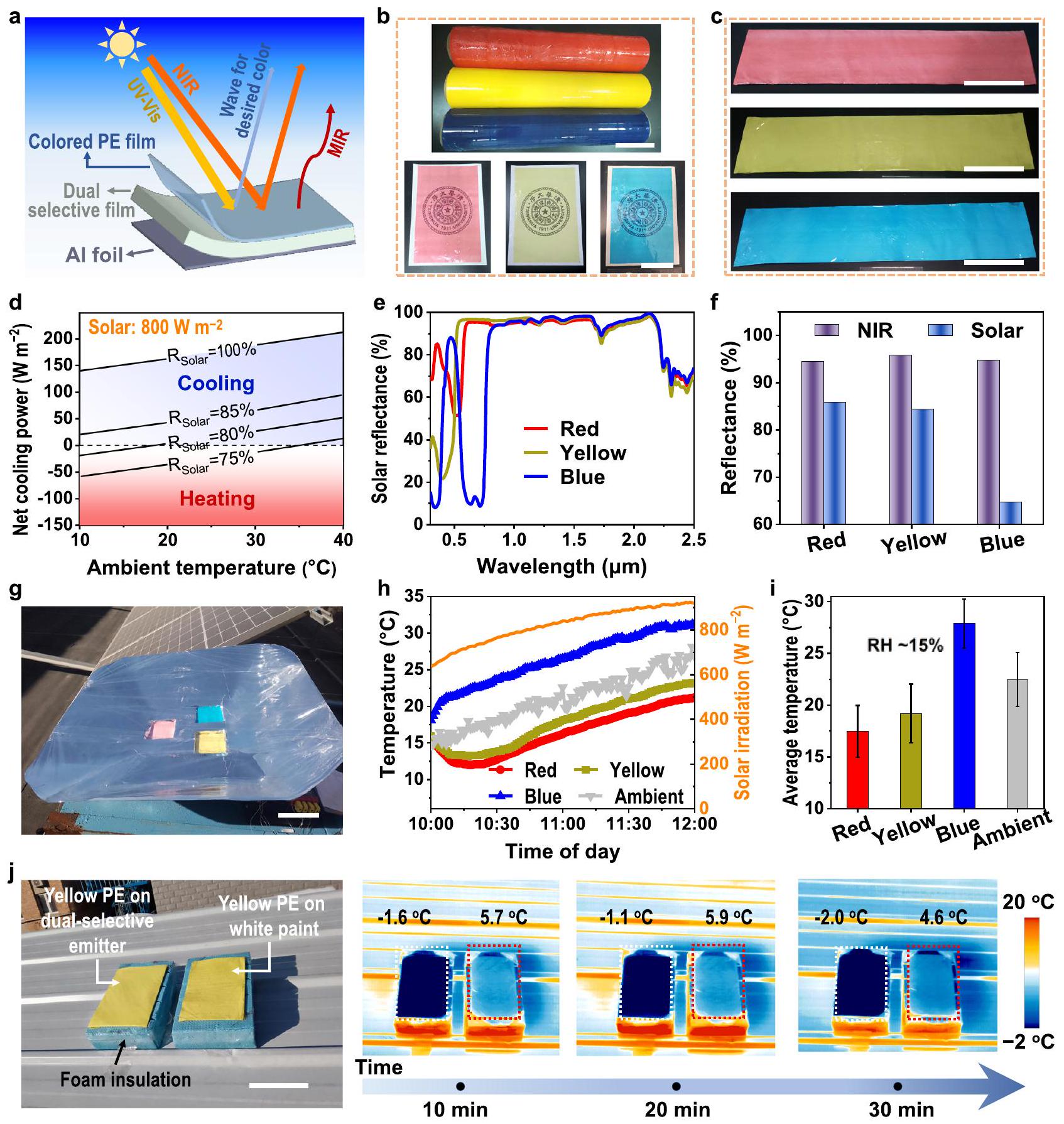
بشكل منفصل. تم تسجيل الأول باستخدام مطياف الأشعة فوق البنفسجية-visible-nearinfrared (UV-vis-NIR) (Cary 7000، Agilent) مزود بنموذج كرة متكاملة (Internal DRA-2500، Agilent، كبريتات الباريوم كمادة أساسية). تم تسجيل الثاني باستخدام
حساب الانعكاسية الشمسية والانبعاثية في MIR
اختبار التعرض للأشعة فوق البنفسجية
اختبار ميكانيكي
اختبار مقاومة الماء
اختبار التعرض الخارجي
قياسات حرارية
ومزدوج حراري من النوع K (كما هو موضح في الشكل 3 أ، ب). تم استخدام ورق الألمنيوم والرغوة في أجهزة الاختبار لتقليل تأثير الحرارة المحيطة، وهي طريقة شائعة الاستخدام في الأعمال السابقة. تم استخدام مزدوجات حرارية من النوع K لمراقبة درجة حرارة العينة في الوقت الحقيقي، والتي تم معايرتها بعناية لضمان أن الفرق بين درجات الحرارة المقاسة ناتج بشكل أساسي عن الفرق بين العينات. تم قياس وتسجيل الظروف البيئية في الوقت الحقيقي (بما في ذلك الرطوبة النسبية، وسرعة الرياح، ودرجة الحرارة المحيطة) خلال القياسات الحرارية بواسطة محطة الطقس (NK5500، كستريل) الواقعة بجوار أجهزة الاختبار. تم قياس وتسجيل الطاقة الشمسية المدخلة بواسطة مقياس طاقة شمسية مسجل للبيانات (TES-1333R) الواقع بجوار أجهزة الاختبار.
قياسات أداء التبريد الخارجي الحقيقي
ملخص التقرير
توفر البيانات
References
- Raman, A. P., Anoma, M. A., Zhu, L., Rephaeli, E. & Fan, S. Passive radiative cooling below ambient air temperature under direct sunlight. Nature 515, 540-544 (2014).
- Rephaeli, E., Raman, A. & Fan, S. Ultrabroadband photonic structures to achieve high-performance daytime radiative cooling. Nano Lett. 13, 1457-1461 (2013).
- Yin, X., Yang, R., Tan, G. & Fan, S. Terrestrial radiative cooling: using the cold universe as a renewable and sustainable energy source. Science 370, 786-791 (2020).
- Tang, K. et al. Temperature-adaptive radiative coating for all-season household thermal regulation. Science 374, 1504-1509 (2021).
- Chen, Z., Zhu, L., Raman, A. & Fan, S. Radiative cooling to deep subfreezing temperatures through a 24 -h day-night cycle. Nat. Commun. 7, 13729 (2016).
- Zhao, D. et al. Subambient cooling of water: toward real-world applications of daytime radiative cooling. Joule 3, 111-123 (2019).
- Fan, S. & Li, W. Photonics and thermodynamics concepts in radiative cooling. Nat. Photonics 16, 182-190 (2022).
- Goldstein, E. A., Raman, A. P. & Fan, S. Sub-ambient non-evaporative fluid cooling with the sky. Nat. Energy 2, 17143 (2017).
- Mandal, J. et al. Hierarchically porous polymer coatings for highly efficient passive daytime radiative cooling. Science 362, 315-318 (2018).
- Zeng, S. et al. Hierarchical-morphology metafabric for scalable passive daytime radiative cooling. Science 373, 692-696 (2021).
- Kou, J.-l, Jurado, Z., Chen, Z., Fan, S. & Minnich, A. J. Daytime radiative cooling using near-black infrared emitters. ACS Photonics 4, 626-630 (2017).
- Li, T. et al. A radiative cooling structural material. Science 364, 760-763 (2019).
- Wang, X. et al. Scalable flexible hybrid membranes with photonic structures for daytime radiative cooling. Adv. Funct. Mater. 30, 1907562 (2019).
- Zhou, L. et al. A polydimethylsiloxane-coated metal structure for allday radiative cooling. Nat. Sustain. 2, 718-724 (2019).
- Zhai, Y. et al. Scalable-manufactured randomized glass-polymer hybrid metamaterial for daytime radiative cooling. Science 355, 1062-1066 (2017).
- Zhu, R. et al. Plasmon-enhanced infrared emission approaching the theoretical limit of radiative cooling ability. Nano Lett. 20, 6974-6980 (2020).
- Wang, T. et al. A structural polymer for highly efficient all-day passive radiative cooling. Nat. Commun. 12, 365 (2021).
- Zhu, B. et al. Subambient daytime radiative cooling textile based on nanoprocessed silk. Nat. Nanotechnol. 16, 1342-1348 (2021).
- Li, J. et al. Protecting ice from melting under sunlight via radiative cooling. Sci. Adv. 8, eabj9756 (2022).
- Li, D. et al. Scalable and hierarchically designed polymer film as a selective thermal emitter for high-performance all-day radiative cooling. Nat. Nanotechnol. 16, 153-158 (2021).
- Yin, H. Y., Yao, H. W., Jia, Y. L., Wang, J. Q. & Fan, C. Z. Realization of efficient radiative cooling in thermal emitter with inorganic metamaterials. J. Phys. D: Appl. Phys. 54, 345501 (2021).
- Lin, C. et al. A solution-processed inorganic emitter with high spectral selectivity for efficient subambient radiative cooling in hot humid climates. Adv. Mater. 34, e2109350 (2022).
- Zhang, X. et al. A moisture-wicking passive radiative cooling hierarchical metafabric. ACS Nano 16, 2188-2197 (2022).
- Zhao, D. L. et al. Radiative sky cooling: Fundamental principles, materials, and applications. Appl. Phys. Rev. 6, 997-1015 (2019).
- Li, W., Shi, Y., Chen, Z. & Fan, S. Photonic thermal management of coloured objects. Nat. Commun. 9, 4240 (2018).
- Chen, Y. et al. Colored and paintable bilayer coatings with high solar-infrared reflectance for efficient cooling. Sci. Adv. 6, eaaz5413 (2020).
- Wang, X. Y. et al. Sub-ambient full-color passive radiative cooling under sunlight based on efficient quantum-dot photoluminescence. Sci. Bull. 67, 1874-1881 (2022).
- Sun, X. S., Sun, Y. B., Zhou, Z. G., Alam, M. A. & Bermel, P. Radiative sky cooling: fundamental physics, materials, structures, and applications. Nanophotonics 6, 997-1015 (2017).
- Zou, C. J. et al. Metal-loaded dielectric resonator metasurfaces for radiative cooling. Adv. Opt. Mater. 5, 1700460 (2017).
- Wang, L., Zheng, Z. H., Gou, Y. C., Liang, W. W. & Yu, W. Fabry-Perot resonance assisted dual-layer coating with enhanced wavelengthselective refection and emission for daytime radiative cooling. Opt. Commun. 483, 126673 (2021).
- Yuan, J. C., Yin, H. L., Yuan, D., Yang, Y. J. & Xu, S. Y. On daytime radiative cooling using spectrally selective metamaterial based building envelopes. Energy 242, 122779 (2022).
- Lesk, C. et al. Compound heat and moisture extreme impacts on global crop yields under climate change. Nat. Rev. Earth Env. 3, 872-889 (2022).
- Lesk, C. et al. Stronger temperature-moisture couplings exacerbate the impact of climate warming on global crop yields. Nat. Food 2, 683-691 (2021).
- Chen, M., Pang, D., Chen, X., Yan, H. & Yang, Y. Passive daytime radiative cooling: fundamentals, material designs, and applications. EcoMat 4, e12153 (2021).
- Lord, S. D. in In NASA Technical Memorandum. 103957 (NASA).
- Nellis, G. F., Klein, S. A., Nellis, G. & Klein, S. Natural Convection. (2009).
- Awbi, H. B. & Hatton, A. Natural convection from heated room surfaces. Energy Build. 30, 233-244 (1999).
- Behera, S. K., Park, S. Y. & Gierschner, J. Dual emission: classes, mechanisms, and conditions. Angew. Chem. Int. Ed. 60, 22624-22638 (2021).
- Jiang, L. et al. Large Stokes shift fluorescent RNAs for dual-emission fluorescence and bioluminescence imaging in live cells. Nat. Methods 20, 1563-1572 (2023).
- Liu, X. et al. Taming the blackbody with infrared metamaterials as selective thermal emitters. Phys. Rev. Lett. 107, 045901 (2011).
- Tang, X., Ackerman, M. M., Chen, M. L. & Guyot-Sionnest, P. Dualband infrared imaging using stacked colloidal quantum dot photodiodes. Nat. Photonics 13, 277-283 (2019).
- Zheng, H. Q. et al. Photo-stimuli-responsive dual-emitting luminescence of a spiropyran-encapsulated metal-organic framework for dynamic information encryption. Adv. Mater. 35, 2300177 (2023).
- Hu, D. W. & Gu, Y. A membrane reflector, polymer hybrid infrared emitter for better radiative cooling performance. Sol. Energy Mater. Sol. Cells 234, 111417 (2022).
- Liang, J. et al. Radiative cooling for passive thermal management towards sustainable carbon neutrality. Natl. Sci. Rev. 10, nwac208 (2023).
- Zhou, Z., Wang, X., Ma, Y., Hu, B. & Zhou, J. Transparent polymer coatings for energy-efficient daytime window cooling. Cell Rep. Phys. Sci. 1, 100231 (2020).
- Aili, A. et al. Selection of polymers with functional groups for daytime radiative cooling. Mater. Today Phys. 10, 100127 (2019).
- NIST Chemistry WebBook, https://webbook.nist.gov/chemistry/.
- National Institute of Advanced Industrial Science and Technology (AIST), <https://sdbs.db.aist.go.jp/sdbs/cgi-bin/cre_ index.cgi>.
- Kennedy, E. R. & Ashley, K. Fourier-transform infrared spectrometry attenuated total reflectance study of the reaction of pentanal and propanal with 2-(Hydroxymethyl) Piperidine. Appl. Spectrosc. 46, 266-272 (1992).
- Zhang, H. et al. Comparative study on the mechanical, tribological, and thermal properties of POM composites filled with different PTFE. J. Thermoplast. Compos. 35, 1319-1341 (2022).
- Wu, X. et al. An all-weather radiative human body cooling textile. Nat. Sustain. 6, 1446-1454 (2023).
- Bognitzki, M. et al. Nanostructured fibers via electrospinning. Adv. Mater. 13, 70-72 (2001).
- Lu, J. W. et al. High-elongation fiber mats by electrospinning of polyoxymethylene. Macromolecules 41, 3762-3764 (2008).
- Kongkhlang, T. et al. Electrospun polyoxymethylene: spinning conditions and its consequent nanoporous nanofiber. Macromolecules 41, 4746-4752 (2008).
- Song, J. N. et al. Durable radiative cooling against environmental aging. Nat. Commun. 13, 4805 (2022).
- Hsu, P. C. et al. Radiative human body cooling by nanoporous polyethylene textile. Science 353, 1019-1023 (2016).
- Peng, Y. & Cui, Y. Advanced textiles for personal thermal management and energy. Joule 4, 724-742 (2020).
- Dong, Y. et al. “Warm in Winter and Cool in Summer”: scalable biochameleon inspired temperature-adaptive coating with easy preparation and construction. Nano Lett 23, 9034-9041 (2023).
- Lin, K.-T. et al. Highly efficient flexible structured metasurface by roll-to-roll printing for diurnal radiative cooling. eLight 3, 22 (2023).
شكر وتقدير
مساهمات المؤلفين
المصالح المتنافسة
معلومات إضافية
المواد التكميلية متاحة على
https://doi.org/10.1038/s41467-024-45095-4.
يجب توجيه المراسلات والطلبات للحصول على المواد إلى روفان زانغ.
http://www.nature.com/reprints
ملاحظة الناشر: تظل شركة سبرينجر ناتشر محايدة فيما يتعلق بالمطالبات القضائية في الخرائط المنشورة والانتماءات المؤسسية.
© المؤلف(ون) 2024
مختبر بكين الرئيسي لهندسة وتكنولوجيا التفاعلات الكيميائية الخضراء، قسم الهندسة الكيميائية، جامعة تسينغhua، بكين، الصين.
المختبر الوطني للهياكل الدقيقة للحالة الصلبة، كلية الهندسة والعلوم التطبيقية، مختبر جيانغسو الرئيسي للمواد الوظيفية الاصطناعية، مركز الابتكار التعاوني للهياكل الدقيقة المتقدمة، جامعة نانجينغ، نانجينغ، الصين. مختبر جي بي إل للبصريات، المختبر الوطني الرئيسي للتألق والتطبيقات، معهد تشانغتشون للبصريات والميكانيكا الدقيقة والفيزياء، الأكاديمية الصينية للعلوم، تشانغتشون، جيلين، جمهورية الصين الشعبية. المختبر الرئيسي للإلكترونيات العضوية والهندسة الجزيئية بوزارة التعليم، قسم الكيمياء، جامعة تسينغhua، بكين، جمهورية الصين الشعبية. البريد الإلكتروني: zhangrufan@tsinghua.edu.cn
DOI: https://doi.org/10.1038/s41467-024-45095-4
PMID: https://pubmed.ncbi.nlm.nih.gov/38280849
Publication Date: 2024-01-27
A dual-selective thermal emitter with enhanced subambient radiative cooling performance
Accepted: 15 January 2024
Published online: 27 January 2024
(A) Check for updates
Abstract
Xueke Wu (B)
Abstract
Radiative cooling is a zero-energy technology that enables subambient cooling by emitting heat into outer space (
response in the mid-infrared (MIR) waveband, these thermal emitters can be mainly categorized into non-selective thermal emitters

performance due to the exclusion of downward atmospheric parasitic heat
both the first and second atmospheric transparent windows, enabling enhanced radiative cooling performance over existing typical thermal emitters. Crucially, the resulting dual-selective thermal emitter exhibits an emittance of
Results
To evaluate the cooling potential of the second atmospheric window, we demonstrated a dual-selective RC model featured with a selective
high absorption/emission in the two atmospheric windows and a high reflection in the remaining non-window MIR and solar wavebands (Fig. 1a, b and Supplementary Fig. 1b). Atmospheric transparency data in an arid climate (obtained from the ATRAN modeling software with a water vapor column of 1.0 mm and zero zenith angle) were used in the calculation to maximize the cooling effect of the second atmospheric window
Material design and characterization

stability, suggesting the potential to provide a better cooling performance than the existing non-selective and mono-selective thermal emitters, especially in arid climates.
Thermal measurements
sunny day (RH

ber 2022). a,
which is also because of its selective MIR spectral property that allows a better cooling performance than the non-selective sample in a low non-radiative heat (near ideal) environment. However, the superiorities disappear when the ambient wind speed increases (1:00 p.m. to 3:00 p.m.) because of the increase in the non-radiative heat around the sample caused by the increased wind speed. The increased non-radiative heat will notably reduce the cooling performance of the mono-selective RC materials, as their net cooling power is much lower than that of non-selective materials.

covered, white paint-Al foil covered, and white paint-coated). Scale bar in c
indicate that the as-designed dual-selective thermal emitter has an enhanced daytime radiative cooling performance over the existing mono-selective and non-selective thermal emitters in real scenarios, especially in arid climates, which is in good agreement with the theoretical analysis (Supplementary text 12).
temperature was visually presented and recorded using an infrared camera (Testo). The results showed that the dual-selective sample had the lowest surface temperature among these samples, and was approximately
foil boxes (
Color compatibility
Discussion
Methods
Fabrication of POM-PTFE, POM, and PVDF electrospun films
Morphology characterization
Spectral characterization

separately. The former was recorded using an ultraviolet-visible-nearinfrared (UV-vis-NIR) spectrophotometer (Cary 7000, Agilent) equipped with an integrating sphere model (Internal DRA-2500, Agilent, barium sulphate as baseline material). The latter was recorded using a
Solar reflectance and MIR emittance calculation
UV exposure test
Mechanical test
Water resistance test
Outdoor exposure test
Thermal measurements
and a K-type thermocouple (as shown in Fig. 3a, b). The aluminum foil and foam in the test devices were used to minimize the surrounding thermal effect, which is a common method used in previous work. The K-type thermocouples were utilized to monitor the real-time temperature of the sample, which were carefully calibrated to ensure that the difference between measured temperatures was mainly caused by the difference between the samples. The real-time environmental conditions (including relative humidity, wind speed, and ambient temperature) during the thermal measurements were measured and recorded by a weather station (NK5500, Kestrel) located adjacent to the test devices. The input solar power was measured and recorded by a datalogging solar power meter (TES-1333R) located adjacent to the test devices.
Real outdoor cooling performance measurements
Reporting summary
Data availability
References
- Raman, A. P., Anoma, M. A., Zhu, L., Rephaeli, E. & Fan, S. Passive radiative cooling below ambient air temperature under direct sunlight. Nature 515, 540-544 (2014).
- Rephaeli, E., Raman, A. & Fan, S. Ultrabroadband photonic structures to achieve high-performance daytime radiative cooling. Nano Lett. 13, 1457-1461 (2013).
- Yin, X., Yang, R., Tan, G. & Fan, S. Terrestrial radiative cooling: using the cold universe as a renewable and sustainable energy source. Science 370, 786-791 (2020).
- Tang, K. et al. Temperature-adaptive radiative coating for all-season household thermal regulation. Science 374, 1504-1509 (2021).
- Chen, Z., Zhu, L., Raman, A. & Fan, S. Radiative cooling to deep subfreezing temperatures through a 24 -h day-night cycle. Nat. Commun. 7, 13729 (2016).
- Zhao, D. et al. Subambient cooling of water: toward real-world applications of daytime radiative cooling. Joule 3, 111-123 (2019).
- Fan, S. & Li, W. Photonics and thermodynamics concepts in radiative cooling. Nat. Photonics 16, 182-190 (2022).
- Goldstein, E. A., Raman, A. P. & Fan, S. Sub-ambient non-evaporative fluid cooling with the sky. Nat. Energy 2, 17143 (2017).
- Mandal, J. et al. Hierarchically porous polymer coatings for highly efficient passive daytime radiative cooling. Science 362, 315-318 (2018).
- Zeng, S. et al. Hierarchical-morphology metafabric for scalable passive daytime radiative cooling. Science 373, 692-696 (2021).
- Kou, J.-l, Jurado, Z., Chen, Z., Fan, S. & Minnich, A. J. Daytime radiative cooling using near-black infrared emitters. ACS Photonics 4, 626-630 (2017).
- Li, T. et al. A radiative cooling structural material. Science 364, 760-763 (2019).
- Wang, X. et al. Scalable flexible hybrid membranes with photonic structures for daytime radiative cooling. Adv. Funct. Mater. 30, 1907562 (2019).
- Zhou, L. et al. A polydimethylsiloxane-coated metal structure for allday radiative cooling. Nat. Sustain. 2, 718-724 (2019).
- Zhai, Y. et al. Scalable-manufactured randomized glass-polymer hybrid metamaterial for daytime radiative cooling. Science 355, 1062-1066 (2017).
- Zhu, R. et al. Plasmon-enhanced infrared emission approaching the theoretical limit of radiative cooling ability. Nano Lett. 20, 6974-6980 (2020).
- Wang, T. et al. A structural polymer for highly efficient all-day passive radiative cooling. Nat. Commun. 12, 365 (2021).
- Zhu, B. et al. Subambient daytime radiative cooling textile based on nanoprocessed silk. Nat. Nanotechnol. 16, 1342-1348 (2021).
- Li, J. et al. Protecting ice from melting under sunlight via radiative cooling. Sci. Adv. 8, eabj9756 (2022).
- Li, D. et al. Scalable and hierarchically designed polymer film as a selective thermal emitter for high-performance all-day radiative cooling. Nat. Nanotechnol. 16, 153-158 (2021).
- Yin, H. Y., Yao, H. W., Jia, Y. L., Wang, J. Q. & Fan, C. Z. Realization of efficient radiative cooling in thermal emitter with inorganic metamaterials. J. Phys. D: Appl. Phys. 54, 345501 (2021).
- Lin, C. et al. A solution-processed inorganic emitter with high spectral selectivity for efficient subambient radiative cooling in hot humid climates. Adv. Mater. 34, e2109350 (2022).
- Zhang, X. et al. A moisture-wicking passive radiative cooling hierarchical metafabric. ACS Nano 16, 2188-2197 (2022).
- Zhao, D. L. et al. Radiative sky cooling: Fundamental principles, materials, and applications. Appl. Phys. Rev. 6, 997-1015 (2019).
- Li, W., Shi, Y., Chen, Z. & Fan, S. Photonic thermal management of coloured objects. Nat. Commun. 9, 4240 (2018).
- Chen, Y. et al. Colored and paintable bilayer coatings with high solar-infrared reflectance for efficient cooling. Sci. Adv. 6, eaaz5413 (2020).
- Wang, X. Y. et al. Sub-ambient full-color passive radiative cooling under sunlight based on efficient quantum-dot photoluminescence. Sci. Bull. 67, 1874-1881 (2022).
- Sun, X. S., Sun, Y. B., Zhou, Z. G., Alam, M. A. & Bermel, P. Radiative sky cooling: fundamental physics, materials, structures, and applications. Nanophotonics 6, 997-1015 (2017).
- Zou, C. J. et al. Metal-loaded dielectric resonator metasurfaces for radiative cooling. Adv. Opt. Mater. 5, 1700460 (2017).
- Wang, L., Zheng, Z. H., Gou, Y. C., Liang, W. W. & Yu, W. Fabry-Perot resonance assisted dual-layer coating with enhanced wavelengthselective refection and emission for daytime radiative cooling. Opt. Commun. 483, 126673 (2021).
- Yuan, J. C., Yin, H. L., Yuan, D., Yang, Y. J. & Xu, S. Y. On daytime radiative cooling using spectrally selective metamaterial based building envelopes. Energy 242, 122779 (2022).
- Lesk, C. et al. Compound heat and moisture extreme impacts on global crop yields under climate change. Nat. Rev. Earth Env. 3, 872-889 (2022).
- Lesk, C. et al. Stronger temperature-moisture couplings exacerbate the impact of climate warming on global crop yields. Nat. Food 2, 683-691 (2021).
- Chen, M., Pang, D., Chen, X., Yan, H. & Yang, Y. Passive daytime radiative cooling: fundamentals, material designs, and applications. EcoMat 4, e12153 (2021).
- Lord, S. D. in In NASA Technical Memorandum. 103957 (NASA).
- Nellis, G. F., Klein, S. A., Nellis, G. & Klein, S. Natural Convection. (2009).
- Awbi, H. B. & Hatton, A. Natural convection from heated room surfaces. Energy Build. 30, 233-244 (1999).
- Behera, S. K., Park, S. Y. & Gierschner, J. Dual emission: classes, mechanisms, and conditions. Angew. Chem. Int. Ed. 60, 22624-22638 (2021).
- Jiang, L. et al. Large Stokes shift fluorescent RNAs for dual-emission fluorescence and bioluminescence imaging in live cells. Nat. Methods 20, 1563-1572 (2023).
- Liu, X. et al. Taming the blackbody with infrared metamaterials as selective thermal emitters. Phys. Rev. Lett. 107, 045901 (2011).
- Tang, X., Ackerman, M. M., Chen, M. L. & Guyot-Sionnest, P. Dualband infrared imaging using stacked colloidal quantum dot photodiodes. Nat. Photonics 13, 277-283 (2019).
- Zheng, H. Q. et al. Photo-stimuli-responsive dual-emitting luminescence of a spiropyran-encapsulated metal-organic framework for dynamic information encryption. Adv. Mater. 35, 2300177 (2023).
- Hu, D. W. & Gu, Y. A membrane reflector, polymer hybrid infrared emitter for better radiative cooling performance. Sol. Energy Mater. Sol. Cells 234, 111417 (2022).
- Liang, J. et al. Radiative cooling for passive thermal management towards sustainable carbon neutrality. Natl. Sci. Rev. 10, nwac208 (2023).
- Zhou, Z., Wang, X., Ma, Y., Hu, B. & Zhou, J. Transparent polymer coatings for energy-efficient daytime window cooling. Cell Rep. Phys. Sci. 1, 100231 (2020).
- Aili, A. et al. Selection of polymers with functional groups for daytime radiative cooling. Mater. Today Phys. 10, 100127 (2019).
- NIST Chemistry WebBook, https://webbook.nist.gov/chemistry/.
- National Institute of Advanced Industrial Science and Technology (AIST), <https://sdbs.db.aist.go.jp/sdbs/cgi-bin/cre_ index.cgi>.
- Kennedy, E. R. & Ashley, K. Fourier-transform infrared spectrometry attenuated total reflectance study of the reaction of pentanal and propanal with 2-(Hydroxymethyl) Piperidine. Appl. Spectrosc. 46, 266-272 (1992).
- Zhang, H. et al. Comparative study on the mechanical, tribological, and thermal properties of POM composites filled with different PTFE. J. Thermoplast. Compos. 35, 1319-1341 (2022).
- Wu, X. et al. An all-weather radiative human body cooling textile. Nat. Sustain. 6, 1446-1454 (2023).
- Bognitzki, M. et al. Nanostructured fibers via electrospinning. Adv. Mater. 13, 70-72 (2001).
- Lu, J. W. et al. High-elongation fiber mats by electrospinning of polyoxymethylene. Macromolecules 41, 3762-3764 (2008).
- Kongkhlang, T. et al. Electrospun polyoxymethylene: spinning conditions and its consequent nanoporous nanofiber. Macromolecules 41, 4746-4752 (2008).
- Song, J. N. et al. Durable radiative cooling against environmental aging. Nat. Commun. 13, 4805 (2022).
- Hsu, P. C. et al. Radiative human body cooling by nanoporous polyethylene textile. Science 353, 1019-1023 (2016).
- Peng, Y. & Cui, Y. Advanced textiles for personal thermal management and energy. Joule 4, 724-742 (2020).
- Dong, Y. et al. “Warm in Winter and Cool in Summer”: scalable biochameleon inspired temperature-adaptive coating with easy preparation and construction. Nano Lett 23, 9034-9041 (2023).
- Lin, K.-T. et al. Highly efficient flexible structured metasurface by roll-to-roll printing for diurnal radiative cooling. eLight 3, 22 (2023).
Acknowledgements
Author contributions
Competing interests
Additional information
supplementary material available at
https://doi.org/10.1038/s41467-024-45095-4.
Correspondence and requests for materials should be addressed to Rufan Zhang.
http://www.nature.com/reprints
Publisher’s note Springer Nature remains neutral with regard to jurisdictional claims in published maps and institutional affiliations.
© The Author(s) 2024
Beijing Key Laboratory of Green Chemical Reaction Engineering and Technology, Department of Chemical Engineering, Tsinghua University, Beijing, China.
National Laboratory of Solid State Microstructures, College of Engineering and Applied Sciences, Jiangsu Key Laboratory of Artificial Functional Materials, Collaborative Innovation Center of Advanced Microstructures, Nanjing University, Nanjing, China. GPL Photonics Laboratory, State Key Laboratory of Luminescence and Applications, Changchun Institute of Optics, Fine Mechanics and Physics, Chinese Academy of Sciences, Changchun, Jilin, PR China. Key Laboratory of Organic Optoelectronics and Molecular Engineering of the Ministry of Education, Department of Chemistry, Tsinghua University, Beijing, PR China. e-mail: zhangrufan@tsinghua.edu.cn
